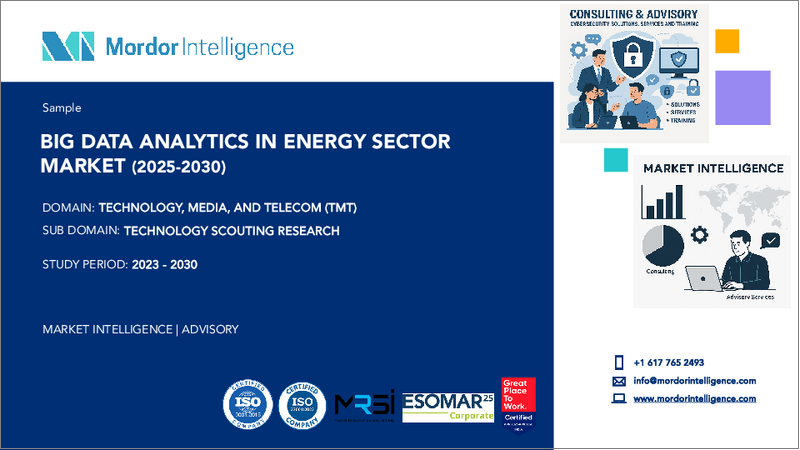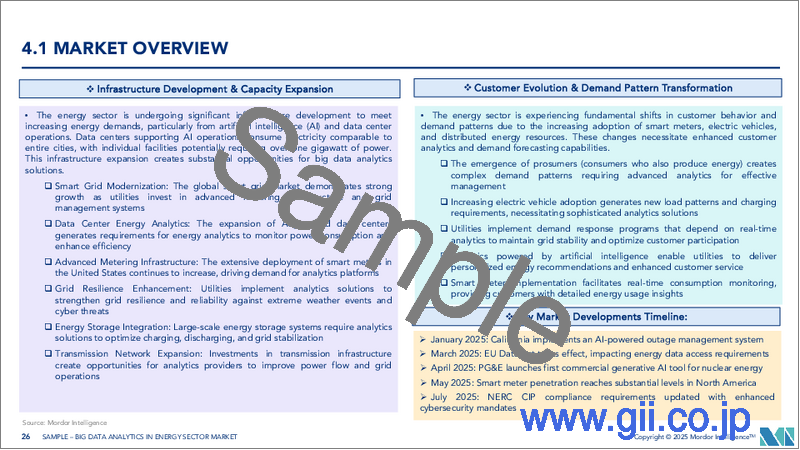|
|
市場調査レポート
商品コード
1686278
エネルギーセクターにおけるビッグデータ分析:市場シェア分析、産業動向・統計、成長予測(2025年~2030年)Big Data Analytics In Energy Sector - Market Share Analysis, Industry Trends & Statistics, Growth Forecasts (2025 - 2030) |
||||||
カスタマイズ可能
適宜更新あり
|
|||||||
| エネルギーセクターにおけるビッグデータ分析:市場シェア分析、産業動向・統計、成長予測(2025年~2030年) |
|
出版日: 2025年03月18日
発行: Mordor Intelligence
ページ情報: 英文 107 Pages
納期: 2~3営業日
|
全表示
- 概要
- 目次
エネルギーセクターにおけるビッグデータ分析市場は、2025年の106億2,000万米ドルから2030年には179億5,000万米ドルに成長し、予測期間(2025~2030年)のCAGRは11.07%になると予測されます。

ビッグデータ・ソリューションは、石油・ガス会社が貯留層の生産効率を向上させるために必要なデータの収集と処理を支援します。データ(温度、音響、圧力など)を取得するために、さまざまな坑内センサーが使用されます。例えば、企業は、貯留層の圧力、温度、流量、音響の変化に関する迅速かつ実用的な情報を提供する貯留層管理システムを構築するために、ビッグデータ分析を使用することができます。これにより、企業は収益性を向上させながら、操業管理を強化することができます。
主なハイライト
- 現在、あらゆるプロセスがエネルギーセクターによって推進され、支えられています。どの企業もこれまで以上に多くのエネルギーを必要とし、それを適正な価格で求めており、ビッグデータとアナリティクスの進歩がそれを現実のものにしています。ビッグデータは、企業が大量の情報(テラバイトやペタバイト)を収集、保存、分析することを可能にします。何年もの間、電力・エネルギー業界はビッグデータを扱い、大量のデータを日常的に処理してきました。
- 毎月データを提供する従来の電力メーターとは異なり、スマートメーターはより詳細なレベルの測定値を分単位で提供することができるため、かなりのデータが生成され、収集されるデータの量が増加します。センサー、ワイヤレス・トランスミッション、ネットワーク通信、クラウド・コンピューティング技術の応用が進んでいるため、データは需要側と供給側の両方から収集されています。
- 原油価格の乱高下はエネルギー関連プロジェクトへの高額支出につながり、ビッグデータ分析の大きな需要を生み出しています。質の高い情報へのニーズが高まっており、これが市場の成長を後押しすると予想されます。
- 現在のシナリオでは、分析のために非構造化データを効果的に扱う熟練した専門家や労働力の不足によって悪化したデジタルスキルやデジタルマインドの不足が、市場の成長を妨げる要因の1つとなっています。
- エネルギー消費は、GDP成長率、工業生産、消費者支出などのマクロ経済変数に直接影響されます。エネルギー消費は一般に、製造、輸送、住宅などいくつかのセクターで経済成長とともに増加します。生産流通と消費に関わるプロセスを最適化するために、エネルギーセクターはますます高度な分析ソリューションを必要としています。例えば、世界銀行の推計によると、2023年に32兆3,200億米ドルだった北米のGDPは、2023年から24年にかけて1.5%増加すると予測されており、企業活動やエネルギーセクターにおけるビッグデータ分析への投資が盛んになると予測されています。
エネルギーセクターにおけるビッグデータ分析市場動向
グリッド運用アプリケーションセグメントが大きな市場シェアを占める見込み
- 世界中でエネルギー需要が高まっています。国際エネルギー機関(IEA)によると、2005年から2030年の間にエネルギー需要は55%拡大し、石油換算で114億トンから177億トンに増加、2050年には世界のエネルギー消費量は886.3兆英熱単位になると予測されています。送電網に電力を供給する太陽光発電などの再生可能エネルギーでは、電力会社は需要反応分析を使って、ピーク時にこれらの電源を解放するタイミングを決定することができます。
- データ分析は、現代の産業システムにおいて重要な役割を担っています。電力網では、従来の化石燃料が枯渇の問題に直面しており、脱炭化水素化によって二酸化炭素排出量を削減することが電力システムに求められています。スマートグリッドとスーパーグリッドは、再生可能エネルギー源の高い普及率によって電化のペースを加速するための効果的なソリューションです。
- 配電システムで使用される従来の電力メーターは、請求のために手動で収集・分析できる少量のデータしか生成しないです。双方向通信のスマートグリッドから様々な時間分解能で収集される膨大な量のデータは、課金情報や電力ネットワークの状態のために重要な情報を抽出するための高度なデータ分析を必要とします。例えば、高解像度のユーザー消費データは、需要予測、顧客行動分析、エネルギー発電の最適化にも利用できます。
- スマートグリッドのビッグデータ分析は、電力業界を変革する可能性があります。しかし、その価値を最大化するためには、適切に利用する必要があります。スマートグリッド・アナリティクスは、バックオフィス・アナリティクス(グリッド接続の監督、負荷予測、信頼性報告などの特定の機能)と分散型アナリティクス(メーター、センサー、その他のデバイスからのデータの分析)に分かれます。
- 高度な計測インフラによるデータ分析に基づく予知保全と故障検出は、電力系統の安全保障にとってより重要です。これらは、ソリューションが組織に統合されたことで、アーリーアダプターによって現在活用されることが期待されているソリューションです。GEのニュー・アナリティクス・テクノロジーズは、送電網の効率を高めています。同社はまた、送電網や配電網からのデータを利用して、より多くの分散型資産が送電網に導入されるにつれて、ユーティリティ企業がより優れた運用効率を達成できるようにする、予測分析の新しいポートフォリオを展開しました。
北米が大きな市場シェアを占める見込み
- 北米は、ビッグデータ分析の導入における主要なイノベーターでありパイオニアの1つです。この地域は、ビッグデータ分析ベンダーの強力な足場により、エネルギーセクターにおけるビッグデータ分析の大規模な需要を示しており、市場成長のための有利な機会を提供しています。
- 米国は、カナダと比較して北米地域の需要拡大に重要な役割を果たしています。特に石油・ガス、精製、発電分野での需要が増加しています。アメリカ人の大多数は、太陽光発電と風力発電を環境に良いエネルギー源と考えています。約65%の人が、風力発電の環境効果は他のほとんどのエネルギー源よりも優れていると考えています。
- 石油・ガス会社は、予知保全ソリューションを適用することで利益を得ています。IoTベースの予知保全により、石油・ガス企業は、起こりうる故障を特定し、重要度の高い資産の生産量を増やすことができます。そのため、シェブロンなどの企業はIoT開発を採用し、腐食やパイプラインの損傷を軽減するための予知保全ソリューションを展開しています。このソリューションでは、パイプライン全体に設置されたセンサーを使用して、パイプラインの内径や厚さとともに、pH、CO2/H2S水溶液含有量、ガス漏れを測定します。このソリューションはリアルタイムのセンサーデータを収集し、評価、分析、予測のためにクラウドに渡します。
- この地域は、スマートグリッド技術導入の最前線にあります。この地域のエネルギー・ユーティリティ部門で事業を展開する多くの企業が、ビッグデータ分析を完全に導入しているか、導入の過程にあります。米国市場では、多くの大規模な投資家所有の公益企業が、顧客向けにスマートメーターを展開中です。米国エネルギー情報局によると、米国では2022年末までに1億1,900万台のスマートメーターが設置される予定であったが、2023年末までに1億2,800万台のスマートメーターの導入が完了しました。
- ビッグデータは、この地域の気象変数を正確に予測するために広く利用されています。異なるデータソースとモデルが、リアルタイム分析のための計算知能技術を使って観測されています。最近、風力発電、太陽光発電、水力発電、バイオマス発電、蓄電池、その他の再生可能技術源を既製品でサポートし、市場をリードする再生可能エネルギー監視・分析プラットフォームであるBazefieldは、機械学習ベースの太陽光発電先進分析パッケージであるゴールドスタンダードEnSightを1つのプラットフォームとしてBazefieldに組み込むことで、太陽光発電機能を強化しました。
エネルギーセクターにおけるビッグデータ分析業界概要
エネルギーセクターにおけるビッグデータ分析市場は、世界プレーヤーと中小企業が存在するため、非常に断片化されています。同市場の主要企業には、IBM Corporation、Siemens AG、SAP SE、Dell Technologies Inc.、Accenture PLCなどがあります。市場のプレーヤーは、製品提供を強化し、持続可能な競争優位性を獲得するために、提携や買収などの戦略を採用しています。
- 2023年11月- シーメンスは、グリッド・ソフトウェア・パートナーの既存のエコシステムを拡大するため、重要インフラ企業向けに資産計画ソフトウェアと分析ソフトウェアを提供するカナダのCopperleaf社と提携しました。この戦略的パートナーシップは、トランスミッション事業者(TSO)と配電系統運用事業者(DSO)の投資と技術的なグリッドプランニングを最適化することを目的としています。このパートナーシップは、シーメンスのグリッド・プランニング、オペレーション、メンテナンス・ソフトウェアとカッパーリーフの資産管理能力を組み合わせることで、広範な電力系統とグリッド制御分野の専門知識をもたらすことになります。
その他の特典:
- エクセル形式の市場予測(ME)シート
- 3ヶ月間のアナリスト・サポート
目次
第1章 イントロダクション
- 調査の前提条件と市場定義
- 調査範囲
第2章 調査手法
第3章 エグゼクティブサマリー
第4章 市場洞察
- 市場概要
- 業界の魅力度-ポーターのファイブフォース分析
- 供給企業の交渉力
- 買い手・消費者の交渉力
- 新規参入業者の脅威
- 代替品の脅威
- 競争企業間の敵対関係の強さ
- マクロ経済動向の影響評価
第5章 市場力学
- 市場促進要因
- 膨大なデータの流入
- 原油価格の変動
- 市場抑制要因
- 熟練労働者の不足
第6章 市場セグメンテーション
- 用途別
- グリッドオペレーション
- スマートメーター
- 資産・労働力管理
- 地域別
- 北米
- 欧州
- アジア
- オーストラリア・ニュージーランド
- ラテンアメリカ
- 中東・アフリカ
第7章 競合情勢
- 企業プロファイル
- IBM Corporation
- Siemens AG
- SAP SE
- Dell Technologies Inc.
- Accenture PLC
- Infosys Limited
- Intel Corporation
- Microsoft Corporation
- Palantir Technologies Inc.
- Enel X Italia Srl(Enel SpA)
第8章 投資分析
第9章 市場の将来
The Big Data Analytics Market In Energy is expected to grow from USD 10.62 billion in 2025 to USD 17.95 billion by 2030, at a CAGR of 11.07% during the forecast period (2025-2030).

Big data solutions aid in collecting and processing data required by oil and gas firms to improve reservoir production efficiency. Various downhole sensors are used to obtain the data (temperature, acoustic, pressure, etc.). Companies, for example, can use big data analytics to create reservoir management systems that provide fast and actionable information about changes in reservoir pressure, temperature, flow, and acoustics. This allows companies to gain greater control over their operations while enhancing profitability.
Key Highlights
- Every process currently is driven and supported by the energy sector. Every entity requires more energy than ever before and wants it at a reasonable price, and the advancement of big data and analytics has made it a real possibility. Big data enables enterprises to collect, store, and analyze massive amounts of information (terabytes and petabytes). For years, the power and energy industries have worked with big data and routinely processed large amounts of data.
- Unlike conventional electricity meters, which provide data every month, smart meters can give readings on a minute basis that are on a more granular level, causing considerable data generation and resulting in a volumetric increase in data gathered. Data is being collected from both the demand and supply side, owing to the increasing application of sensors, wireless transmission, network communication, and cloud computing technologies.
- The volatility in the oil prices leads to high expenditure on energy-related projects, which creates a major demand for big data analytics. The need for quality information is increasing, which is expected to boost the market's growth.
- In the current scenario, the lack of digital skills and digital mindsets aggravated by the lack of skilled professionals and workforce to handle the unstructured data effectively for analysis is one of the factors hindering the market growth.
- Energy consumption is directly impacted by macroeconomic variables such as GDP growth rates, industrial production, and consumer expenditure. Energy consumption generally rises with economic growth in several sectors, including manufacturing, transportation, and residential. To optimize the processes involved in production distribution and consumption, the energy sector needs increasingly sophisticated analytic solutions. For instance, according to a World Bank estimate, the North American GDP, which was USD 32.32 trillion in 2023, is predicted to increase by 1.5% in 2023-24, suggesting that corporate activity and possible big data analytics in energy sector investments are projected to flourish.
Big Data Analytics in Energy Sector Market Trends
Grid Operations Application Segment is Expected to Hold Significant Market Share
- The demand for energy across the world is rising. According to the International Energy Agency, between 2005 and 2030, energy needs are estimated to expand by 55%, with the demand rising from 11.4 billion metric tons of oil equivalent to 17.7 billion, and the forecasted global energy consumption will be 886.3 quadrillion British thermal units by 2050. With renewable energy sources, such as solar power, which contributes electricity to the power grid, utilities can use demand response analytics to determine the timings to release these power sources during peak demand.
- Data analytics possess a critical role in modern industrial systems. In the power grid, traditional fossil fuels face the problem of depletion, and de-carbonization demands the power system to reduce carbon emissions. Smart grid and super grid are effective solutions to accelerate the pace of electrification with high penetration of renewable energy sources.
- Traditional electricity meters used in distribution systems only produce a small amount of data that can be manually collected and analyzed for billing purposes. The huge volume of data collected from two-way communication smart grids at various time resolutions requires advanced data analytics to extract important information for billing information and the status of the electricity network. For instance, the high-resolution user consumption data can also be used for demand forecasting, customer behavior analysis, and energy generation optimization.
- Smart grid big data analytics can potentially transform the utility industry. However, it needs to be appropriately used to maximize its value. Smart grid analytics divided itself into back-office analytics (certain functions, like overseeing grid connectivity, load forecasting, and reliability reporting) and distributed analytics (analyzing data from meters, sensors, and other devices).
- Predictive maintenance and fault detection based on data analytics with advanced metering infrastructure are more crucial to the security of the power system. They are expected to be the solutions that are expected to be now utilized by the early adopters as the solutions have been integrated into their organization. GE's New Analytics Technologies is boosting grid efficiency. The company has also rolled out a new portfolio of predictive analytics that could allow utilities to use data from transmission and distribution networks to achieve better operational efficiency as more distributed assets are introduced to the grid.
North America is Expected to Hold Significant Market Share
- North America is one of the leading innovators and pioneers in the adoption of big data analytics. The region offers lucrative opportunities for market growth, exhibiting a massive demand for big data analytics in the energy sector owing to the strong foothold of big data analytics vendors.
- The United States plays a key role in proliferating the demand from the North American region compared to Canada. The country has increased demand, especially from oil and gas, refining, and power generation segments. The majority of Americans consider solar and wind power as good sources of energy for the environment. Around 65% of the population suggests that the environmental effect of wind turbine farms is better than that of most other sources.
- The oil and gas companies benefit from applying predictive maintenance solutions. IoT-based predictive maintenance enables oil and gas companies to identify possible failures and increase the production of highly critical assets. Thus, companies such as Chevron employed IoT development to roll out a predictive maintenance solution that helps mitigate corrosion and pipeline damage. The solution uses sensors installed across the pipeline to measure the pH, aqueous CO2/H2S content, and gaseous leakages along with the pipeline's internal diameter and thickness. The solution collects real-time sensor data and passes it to the cloud for evaluation, analysis, and prediction.
- The region has been at the forefront of adopting smart grid technology. A large number of companies operating in the energy utility sector in the region have either fully deployed big data analytics or are in the process of implementation. Many large investor-owned utilities in the US market are still in the process of rolling out smart meters for their customers. According to the US Energy Information Administration, 119 million smart meters were to be installed in the US by the end of 2022, whereas 128 million smart meter deployments were completed by the end of 2023.
- Big data is extensively being used for the accurate prediction of meteorological variables in the region. Disparate data sources and models are observed using computational intelligence techniques for real-time analysis. Recently, Bazefield, the market-leading renewable monitoring and analytics platform with off-the-shelf support for wind power, solar, hydro, biomass, battery storage, and other renewable technology sources, enhanced its solar capabilities by embedding the gold standard EnSight, machine learning-based solar advanced analytics package, into Bazefield as one single platform.
Big Data Analytics in Energy Sector Industry Overview
Big data analytics in the energy sector market is highly fragmented due to the presence of global players and small- and medium-sized enterprises. Some of the major players in the market are IBM Corporation, Siemens AG, SAP SE, Dell Technologies Inc., and Accenture PLC. Players in the market are adopting strategies such as partnerships and acquisitions to enhance their product offerings and gain sustainable competitive advantage.
- November 2023 - Siemens partnered with Copperleaf, a Canadian-based provider of asset planning software and analytics software for critical infrastructure companies, to grow its existing ecosystem of grid software partners. The strategic partnership aims to optimize investment and technical grid planning for transmission system operators (TSOs) and distribution system operators (DSOs). The partnership will bring extensive power systems and grid control domain expertise, combining Siemens grid planning, operations, and maintenance software and Copperleaf's assets management capabilities.
Additional Benefits:
- The market estimate (ME) sheet in Excel format
- 3 months of analyst support
TABLE OF CONTENTS
1 INTRODUCTION
- 1.1 Study Assumptions and Market Definition
- 1.2 Scope of the Study
2 RESEARCH METHODOLOGY
3 EXECUTIVE SUMMARY
4 MARKET INSIGHTS
- 4.1 Market Overview
- 4.2 Industry Attractiveness - Porter's Five Forces Analysis
- 4.2.1 Bargaining Power of Suppliers
- 4.2.2 Bargaining Power of Buyers/ Consumers
- 4.2.3 Threat of New Entrants
- 4.2.4 Threat of Substitutes
- 4.2.5 Intensity of Competitive Rivalry
- 4.3 An Assessment of the Impact of Macroeconomics Trends
5 MARKET DYNAMICS
- 5.1 Market Drivers
- 5.1.1 Enormous Influx of Data
- 5.1.2 Volatility in the Oil Prices
- 5.2 Market Restraints
- 5.2.1 Lack of Skilled Labor
6 MARKET SEGMENTATION
- 6.1 By Application
- 6.1.1 Grid Operations
- 6.1.2 Smart Metering
- 6.1.3 Asset and Workforce Management
- 6.2 By Geography
- 6.2.1 North America
- 6.2.2 Europe
- 6.2.3 Asia
- 6.2.4 Australia and New Zealand
- 6.2.5 Latin America
- 6.2.6 Middle East and Africa
7 COMPETITIVE LANDSCAPE
- 7.1 Company Profiles
- 7.1.1 IBM Corporation
- 7.1.2 Siemens AG
- 7.1.3 SAP SE
- 7.1.4 Dell Technologies Inc.
- 7.1.5 Accenture PLC
- 7.1.6 Infosys Limited
- 7.1.7 Intel Corporation
- 7.1.8 Microsoft Corporation
- 7.1.9 Palantir Technologies Inc.
- 7.1.10 Enel X Italia Srl (Enel SpA)





